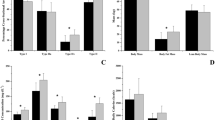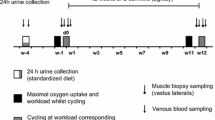Abstract
Carnosine is found in high concentrations in skeletal muscles, where it is involved in several physiological functions. The muscle carnosine content measured within a population can vary by a factor 4. The aim of this study was to further characterize suggested determinants of the muscle carnosine content (diet, gender and age) and to identify new determinants (plasma carnosinase activity and testosterone). We investigated a group of 149 healthy subjects, which consisted of 94 men (12 vegetarians) and 55 women. Muscle carnosine was quantified in M. soleus, gastrocnemius and tibialis anterior using magnetic resonance proton spectroscopy and blood samples were collected to determine CNDP1 genotype, plasma carnosinase activity and testosterone concentrations. Compared to women, men have 36, 28 and 82% higher carnosine concentrations in M. soleus, gastrocnemius and tibialis anterior muscle, respectively, whereas circulating testosterone concentrations were unrelated to muscle carnosine levels in healthy men. The carnosine content of the M. soleus is negatively related to the subjects’ age. Vegetarians have a lower carnosine content of 26% in gastrocnemius compared to omnivores. In contrast, there is no difference in muscle carnosine content between omnivores with a high or low ingestion of β-alanine. Muscle carnosine levels are not related to the polymorphism of the CNDP1 gene or to the enzymatic activity of the plasma carnosinase. In conclusion, neither CNDP1 genotype nor the normal variation in circulating testosterone levels affects the muscular carnosine content, whereas vegetarianism, female gender and increasing age are the factors associated with reduced muscle carnosine stores.






Similar content being viewed by others
References
Abe H (2000) Role of histidine-related compounds as intracellular proton buffering constituents in vertebrate muscle. Biochemistry (Mosc) 65:757–765
Baguet A, Reyngoudt H, Pottier A, Everaert I, Callens S, Achten E, Derave W (2009) Carnosine loading and washout in human skeletal muscles. J Appl Physiol 106:837–842
Baguet A, Koppo K, Pottier A, Derave W (2010) β-Alanine supplementation reduces acidosis but not oxygen uptake response during high-intensity cycling exercise. Eur J Appl Physiol 108:495–503
Bando K, Shimotsuji T, Oyoshima H, Miyae K (1984) Fluorometric assay of human serum carnosinase activity in normal children, adults and patients with myopathy. Ann Clin Biochem 21:510–514
Bate Smith EC (1938) The buffering of muscle in rigor: protein, phosphate and carnosine. J Physiol 92:336–343
Boldyrev AA (2007) Carnosine and oxidative stress in cells and tissues. Nova Science, New York
Burke DG, Chilibeck PD, Parise G, Candow DG, Mahoney D, Tarnopolsky M (2003) Effect of creatine and weight training on muscle creatine and performance in vegetarians. Med Sci Sports Exerc 35:1946–1955
Derave W, Ozdemir MS, Harris RC, Pottier A, Reyngoudt H, Koppo K, Wise JA, Achten E (2007) β-Alanine supplementation augments muscle carnosine content and attenuates fatigue during repeated isokinetic contraction bouts in trained sprinters. J Appl Physiol 103:1736–1743
Derave W, Jones G, Hespel P, Harris RC (2008) Creatine supplementation augments skeletal muscle carnosine content in senescence-accelerated mice (SAMP8). Rejuvenation Res 11:641–647
Derave W, Everaert I, Beeckman S, Baguet A (2010) Muscle carnosine and β-alanine in relation to exercise and training. Sports Med 40:247–263
Drozak J, Veiga-da-Cunha M, Vertommen D, Stroobant V, Van Schaftingen E (2010) Molecular identification of carnosine synthase as ATP-grasp domain-containing protein 1 (ATPGD1). J Biol Chem 285:9346–9356
Dutka TL, Lamb GD (2004) Effect of carnosine on excitation–contraction coupling in mechanically-skinned rat skeletal muscle. J Muscle Res Cell Motil 25:203–213
Enette Larson-Meyer D (2006) Vegetarian sports nutrition. Human Kinetics, Champaign
Freedman BI, Hicks PJ, Sale MM, Pierson ED, Langefeld CD, Rich SS, Xu J, McDonough C, Janssen B, Yard BA, van der Woude FJ, Bowden DW (2007) A leucine repeat in the carnosinase gene CNDP1 is associated with diabetic end-stage renal disease in European Americans. Nephrol Dial Transplant 22:1131–1135
Harris RC, Dunnett M, Greenhaff PL (1998) Carnosine and taurine contents in individual fibres of human vastus lateralis muscle. J Sport Sci 16:639–643
Harris RC, Tallon MJ, Dunnett M, Boobis L, Coakley J, Kim HJ, Fallowfield JL, Hill CA, Sale C, Wise JA (2006) The absorption of orally supplied β-alanine and its effect on muscle carnosine synthesis in human vastus lateralis. Amino Acids 30:279–289
Harris RC, Jones G, Hill CA, Kendrick IP, Boobis LH, Kim CK, Kim HJ, Dang VH, Edge J, Wise JA (2007) The carnosine content of vastus lateralis in vegetarians and omnivores. FASEB J 21:A944
Hill CA, Harris RC, Kim HJ, Harris BD, Sale C, Boobis LH, Kim CK, Wise JA (2007) Influence of β-alanine supplementation on skeletal muscle carnosine concentrations and high intensity cycling capacity. Amino Acids 32:225–233
Hipkiss AR, Michaelis J, Syrris P (1995) Non-enzymatic glycosylation of the dipeptide l-carnosine, a potential anti-protein-cross-linking agent. FEBS Lett 371:81–85
Janssen B, Hohenadel D, Brinkkoetter P, Peters V, Rind N, Fischer C, Rychlik I, Cerna M, Romzova M, de Heer E, Baelde H, Bakker SJ, Zirie M, Rondeau E, Mathieson P, Saleem MA, Meyer J, Koppel H, Sauerhoefer S, Bartram CR, Nawroth P, Hammes HP, Yard BA, Zschocke J, van der Woude FJ (2005) Carnosine as a protective factor in diabetic nephropathy: association with a leucine repeat of the carnosinase gene CNDP1. Diabetes 54:2320–2327
Johnson P, Hammer JL (1992) Histidine dipeptide levels in ageing and hypertensive rat skeletal and cardiac muscles. Comp Biochem Physiol B 103:981–984
Kaufman JM, Vermeulen A (2005) The decline of androgen levels in elderly men and its clinical and therapeutic implications. Endocr Rev 26:833–876
Kendrick IP, Kim HJ, Harris RC, Kim CK, Dang VH, Lam TQ, Bui TT, Wise JA (2009) The effect of 4 weeks β-alanine supplementation and isokinetic training on carnosine concentrations in type I and II human skeletal muscle fibres. Eur J Appl Physiol 106:131–138
Kohen R, Yamamoto Y, Cundy KC, Ames BN (1988) Antioxidant activity of carnosine, homocarnosine, and anserine present in muscle and brain. Proc Natl Acad Sci USA 85:3175–3179
Lamont C, Miller D (1992) Calcium sensitizing action of carnosine and other endogenous imidazoles in chemically skinned striated muscle. J Physiol 454:421–434
Mannion AF, Jakeman PM, Dunnett M, Harris RC, Willan PL (1992) Carnosine and anserine concentrations in the quadriceps femoris muscle of healthy humans. Eur J Appl Physiol Occup Physiol 64:47–50
Mannion AF, Jakeman PM, Willan PL (1995) Skeletal muscle buffer value, fibre type distribution and high intensity exercise performance in man. Exp Physiol 80:89–101
Marlin DJ, Harris RC, Gash SP, Snow DH (1989) Carnosine content of the middle gluteal muscle in thoroughbred horses with relation to age, sex and training. Comp Biochem Physiol A Comp Physiol 93:629–632
Mooyaart AL, van Valkengoed IG, Shaw PK, Peters V, Baelde HJ, Rabelink TJ, Bruijn JA, Stronks K, de Heer E (2009) Lower frequency of the 5/5 homozygous CNDP1 genotype in South Asian Surinamese. Diabetes Res Clin Pract 85:272–278
Mooyaart AL, Zutinic A, Bakker SJ, Grootendorst DC, Kleefstra N, van Valkengoed IG, Böhringer S, Bilo H, Dekker F, Bruijn JA, Navis G, Janssen B, Baelde H, De Heer E (2010) Association between CNDP1 genotype and diabetic nephropathy is sex-specific. Diabetes 59:1555–1559
Ozdemir MS, Reyngoudt H, De DY, Sazak HS, Fieremans E, Delputte S, D’Asseler Y, Derave W, Lemahieu I, Achten E (2007) Absolute quantification of carnosine in human calf muscle by proton magnetic resonance spectroscopy. Phys Med Biol 52:6781–6794
Parkhouse WS, McKenzie DC, Hochachka PW, Ovalle WK (1985) Buffering capacity of deproteinized human vastus lateralis muscle. J Appl Physiol 58:14–17
Penafiel R, Ruzafa C, Monserrat F, Cremades A (2004) Gender-related differences in carnosine, anserine and lysine content of murine skeletal muscle. Amino Acids 26:53–58
Peters V, Kebbewar M, Jansen E, Jakobs C, Riedl E, Koeppel H, Frey D, Adelmann K, Klingbeil K, Mack M, Hoffmann GF, Janssen B, Zschocke J, Yard BA (2009) Relevance of allosteric conformations and homocarnosine concentration on carnosinase activity 38:1607–1615
Ponte J, Harris RC, Hill CA, Sale C, Jones GA, Kim HJ, Wise JA (2006) Effect of 14 and 28 days β-alanine supplementation on isometric endurance of the knee extensors. J Sports Sci 25:344
Riedl E, Koeppel H, Brinkkoetter P, Sternik P, Steinbeisser H, Sauerhoefer S, Janssen B, van der Woude FJ, Yard BA (2007) A CTG polymorphism in the CNDP1 gene determines the secretion of serum carnosinase in Cos-7 transfected cells. Diabetes 56:2410–2413
Sale C, Saunders B, Harris RC (2010) Effect of β-alanine supplementation on muscle carnosine concentration and exercise performance. Amino Acids 39:321–333
Simoneau JA, Bouchard C (1989) Human variation in skeletal muscle fiber-type proportion and enzyme activities. Am J Physiol 257:E567–E572
Staron RS, Hagerman FC, Hikida RS, Murray TF, Hostler DP, Crill MT, Ragg KE, Toma K (2000) Fiber type composition of the vastus lateralis muscle of young men and women. J Histochem Cytochem 48:623–629
Stout JR, Cramer JT, Zoeller RF, Torok D, Costa P, Hoffman JR, Harris RC, O’Kroy J (2007) Effects of β-alanine supplementation on the onset of neuromuscular fatigue and ventilatory threshold in women. Amino Acids 32:381–386
Stout JR, Graves BS, Smith AE, Hartman MJ, Cramer JT, Beck TW, Harris RC (2008) The effect of β-alanine supplementation on neuromuscular fatigue in elderly (55–92 years): a double-blind randomized study. J Int Soc Sports Nutr 5:21
Stuerenburg HJ, Kunze K (1999) Concentrations of free carnosine (a putative membrane-protective antioxidant) in human muscle biopsies and rat muscles. Arch Gerontol Geriatr 29:107–113
Suzuki Y, Ito O, Mukai N, Takahashi H, Takamatsu K (2002) High level of skeletal muscle carnosine contributes to the latter half of exercise performance during 30-s maximal cycle ergometer sprinting. Jpn J Physiol 52:199–205
Suzuki Y, Nakao T, Maemura H, Sato M, Kamahara K, Morimatsu F, Takamatsu K (2006) Carnosine and anserine ingestion enhances contribution of nonbicarbonate buffering. Med Sci Sports Exerc 38:334–338
Tallon MJ, Harris RC, Boobis LH, Fallowfield JL, Wise JA (2005) The carnosine content of vastus lateralis is elevated in resistance-trained bodybuilders. J Strength Cond Res 19:725–729
Tallon MJ, Harris RC, Maffulli N, Tarnololsky M (2007) Carnosine, taurine and enzyme activities of human skeletal muscle fibres from elderly subjects with osteoarthritis and young moderately active subjects. Biogerontology 8:129–137
Teufel M, Saudek V, Ledig JP, Bernhardt A, Boularand S, Carreau A, Cairns NJ, Carter C, Cowley DJ, Duverger D, Ganzhorn AJ, Guenet C, Heintzelmann B, Laucher V, Sauvage C, Smirnova T (2003) Sequence identification and characterization of human carnosinase and a closely related non-specific dipeptidase. J Biol Chem 278:6521–6531
Van Thienen R, Van Proeyen K, Vanden Eynde B, Puype J, Lefere T, Hespel P (2009) β-Alanine improves sprint performance in endurance cycling. Med Sci Sports Exerc 41:898–903
Vermeulen A, Verdonck L, Kaufman JM (1999) A critical evaluation of simple methods for the estimation of free testosterone in serum. J Clin Endocrinol Metab 84:3666–3672
Acknowledgments
This study was financially supported by grants from the Research Foundation—Flanders (FWO 1.5.149.08 and G.0046.09) and by the EU-funded specifically targeted project, PREDICTIONS, to identify risk factors for developing diabetic nephropathy (FP6-018733, http://www.predictions-project.eu). Audrey Baguet is a recipient of a PhD-scholarship from the Research Foundation—Flanders. MRS was performed at GIfMI (http://www.gifmi.be). The authors declare that they have no conflict of interest.
Author information
Authors and Affiliations
Corresponding author
Rights and permissions
About this article
Cite this article
Everaert, I., Mooyaart, A., Baguet, A. et al. Vegetarianism, female gender and increasing age, but not CNDP1 genotype, are associated with reduced muscle carnosine levels in humans. Amino Acids 40, 1221–1229 (2011). https://doi.org/10.1007/s00726-010-0749-2
Received:
Accepted:
Published:
Issue Date:
DOI: https://doi.org/10.1007/s00726-010-0749-2




